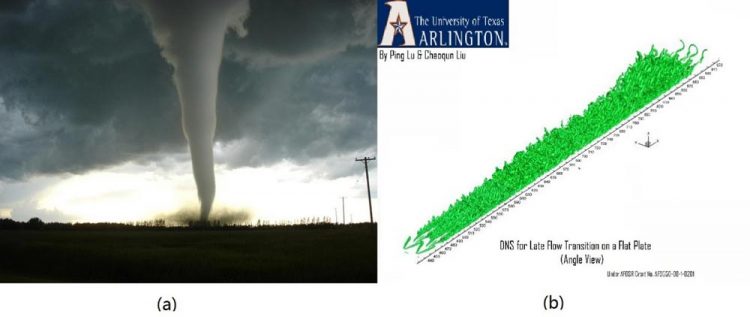A new vortex identification method for 3-D complex flow

Vortices (a) tornado (b) late boundary layer transition. Credit: ©Science China Press
The paper titled as “new omega vortex identification method” has been published on volume (59)2016 by Science China: Physics, Mechanics & Astronomy. The authors reviewed Helmoholtz velocity decomposition and presented a new vortex identification method: the method based on a deep understanding on physics of vortex structure.
This method was given by Chaoqun Liu, a professor from the University of Texas at Arlington (UTA.) Researchers including Yong Yang from UTA, Yiqian Wang from Nanjing University of Aeronautics and Astronautics in China, Zhiwei Duan from Tsinghua University in China and Zhengzhong Sun from London City University in UK have applied this new method to variety of complex 3-D flows and all outcomes are promising, further proving the method is correct and accurate.
The authors proposed a further decomposition of the vorticity to vortical part and non-vortical part after reviewed Helmoholtzz velocity decomposition and some counterexamples like Blasius solution which has large vorticity but has no vortex. They introduced a so-called to define and identify vortex. is a ratio of vorticity square over the sum of vorticity square and deformation square.
According to the ratio, vortex is defined when vorticity overtakes deformation or >0.5. The iso-surface of =0.52 is utilized to represent the vortex surface and further to visualize the vortex structure of the flow field. These researchers applied the method for 3 different cases including late boundary layer transition, supersonic micro vortex generator and roughness induced transition.
Although the three cases have very different Mach number which means the compressibility affection are quite different, the iso-surface of =0.52 well represent the vortex structure without wild adjustment of threshold for all three cases.
This is a unprecedented effort to give vortex a mathematical definition. All traditional vortex identification methods have a common critical weakness which is requirement of selection of a proper threshold. The threshold could be wildly changed case by case, time by time, and even area by area in same case.
Different thresholds will lead to different vortex structure and no one is able to know which threshold is appropriate and which vortex structure is correct. Being different from the traditional vortex identification methods, the method is quite universal and has no need to set up a threshold case by case.
In addition, the method has other advantages which include being easy to perform, having clear physical meaning, and high capability to capture both strong and weak vortices. In general, people think vortex is “vorticity tube”, but the method indicates that vortex is a region where vorticity overtakes deformation and vortex is not vorticity tube.
Traditional vortex identification can cause many misunderstandings. For example, people believe turbulence is caused by “vortex breakdown”, but it is now understood that this is caused by wrong selection of vortex threshold. It is convinced Dr. Liu's vortex identification method would greatly stimulate research of physics for turbulence generation and complex 3-D flows, especially for vortices dominant flows. It is also believed that many scientists and engineers would apply this method for vortex identification and vortex structure visualization.
###
For details, please see the article:
LIU Chaoqun, WANG Yiqian, YANG Yong & DUAN Zhiwei, New omega vortex identification method, Science China: Physics, Mechanics & Astronomy, 2016, to appear http://engine.
Science China Press http://www.
Media Contact
All latest news from the category: Materials Sciences
Materials management deals with the research, development, manufacturing and processing of raw and industrial materials. Key aspects here are biological and medical issues, which play an increasingly important role in this field.
innovations-report offers in-depth articles related to the development and application of materials and the structure and properties of new materials.
Newest articles

A ‘language’ for ML models to predict nanopore properties
A large number of 2D materials like graphene can have nanopores – small holes formed by missing atoms through which foreign substances can pass. The properties of these nanopores dictate many…

Clinically validated, wearable ultrasound patch
… for continuous blood pressure monitoring. A team of researchers at the University of California San Diego has developed a new and improved wearable ultrasound patch for continuous and noninvasive…

A new puzzle piece for string theory research
Dr. Ksenia Fedosova from the Cluster of Excellence Mathematics Münster, along with an international research team, has proven a conjecture in string theory that physicists had proposed regarding certain equations….



